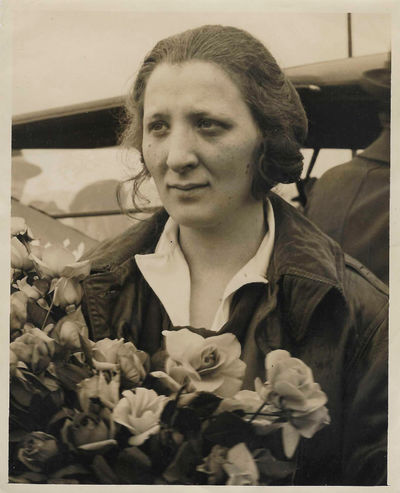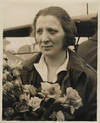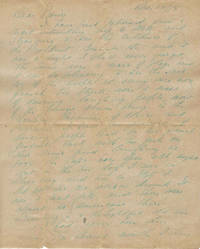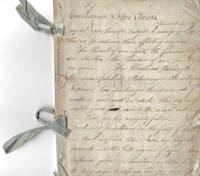by Gatlin, Lillian
The collection includes 61 letters, 118 typescript and manuscript pages, incoming and retained copies and drafts of outgoing letters by Lillian Gatlin. The correspondence includes letters from publishers and authors, including Edward S. Bok, Charmian London, government officials, and aviators.
18 silver print photographs of Lillian Gatlin, measuring XXXX, with 12 photographic negatives. The images document Gatlin's aviation career, as well as snapshots with friends.
15 pages of manuscript verse by Gatlin, 1928, 16 pages of manuscript notes. Typescript Manuscript entitled: Ideas Re At the Sign of the Propeller for Eldon V. Johnson from Lillian Gatlin, octavo, 55 pages, plus mss additions and corrections
8 ephemeral items pertaining to Lillian Gatlin, including 1917 and 1922 newspapers containing stories by and about Lillian Gatlin, and her aviation exploits.
File of correspondence and documents pertaining to Gatlin's mining claim in Sierra County, California, 1935-1968, 15 items
5 miscellaneous receipts
Lillian Gatlin has long faded from memory but in 1922 she was the toast of the nation. On October 8, 1922, Lillian Gatlin became the first woman to travel across the continental United Staes in a plane when she arrived at the U.S. air mail service station at Long Island's Curtiss Field three days after departing from San Francisco. The flight traveled along an air mail route and Gatlin wore a "special delivery" tag on her flying suit. The flight took place under the auspices of Assistant U.S. Postmaster General Paul Henderson.
Gatlin proposed the idea of such a flight in the first place to help promote the goals of the National Association of Aviation Gold Mothers, which she founded to highlight the lives and sacrifices of pilots who were killed while flying. She promoted these goals at the various places she stopped along the cross-country flight: Reno, Nevada, Salt Lake City, Rock Springs, Wyoming, Cheyenne, North Platte and Omaha, Nebraska, Iowa City, Chicago, and Cleveland, Ohio. To further highlight her cause Gatlin made the trip wearing the cuff links of one pilot who died in the line of duty and the goggles of another who died in similar circumstances. The total airtime for the 2,680-mile flight was 27 hours and 11 minutes.
Along with promoting her special cause, Gatlin used her speech after completing the flight to praise the virtues of air travel. "Flying is the ideal method of traveling, … no cinders, no invitations to buy the products advertised on signboards extending from coast to coast, nothing to disturb the easy sailing through the atmosphere."
Lillian Gatlin attended the University of Illinois Urbana-Champaign from 1906-1908. Here she developed her interest in writing. She did not graduate from UIUC but transferred to the University of Michigan for her senior year where she received an A.B. in English in 1909. By 1910 she was teaching English and German at the Coffee County High School in Enterprise, Alabama.
By 1915 she was established as an author and aviatrix in San Francisco, California. In March 1915 her flight instructor (and possible fiancé) the famed barnstormer Lincoln Beachey, died in a crash at the Panama Pacific Exposition in San Francisco. Beginning in 1916 Gatlin flew over Beachy's crash site just off the coast of the Exposition Grounds (now the Marina District) and dropped flowers on the anniversary of his death. As numbers of pilots began dying in World War 1 the event became a citywide and national event commemorating dead aviators. In 1921 it was officially recognized by the city as "Aerial Day."
On the first Aerial Day in 1921, World War I ace Eddie Rickenbacker flew Gatlin over the spot of Beachey's crash where she dropped roses from the plane. The event included speeches from families of deceased pilots, readings from letters written by President Warren G. Harding and General John J. Pershing, and a military air squadron performance.
Gatlin also began writing after Beachey's crash and began work on a novel, Bunnie Gates. The work was a semi-auto-biographical tale of triumph over adversity. However, the work was never printed. Gatlin nevertheless continued writing, working as a scenario writer for film and radio productions. She also wrote for magazines, including articles on adoption, a summation of her wartime work on behalf of animal veterans in Ladies' Home Journal and an account of her 1922 flight published in the San Francisco Examiner. (A copy of which is included in the collection).
Days before Woodrow Wilson declared war on Germany, Gatlin publicly offered her services as a pilot to the United States military. A copy of the Los Angeles Evening Herald, Friday March 30, 1917, carries the story of Gatlin, aka "bird Girl's" offer of her services along with her Curtiss bi-plane to the US Government. Although never called to the front, she volunteered with the Blue Cross, a British animal rights organization. Gatlin toured California with French trench dogs to raise funds for the care of animal veterans.
On October 8, 1922, Lillian Gatlin and Elmer Leonhardt landed their plane in Long Island, as they touched down Gatlin became the first woman to fly across the continent. The event made front page news all across the country. She was feted at events in New York City and Washington, D.C., where she met the president Warren G. Harding.
Although Gatlin did not serve as the pilot, her trip was an important step in the opening of aviation to women. Early women pilots served as passengers according to aviation historian Kathleen Brooks-Pazmany, to dispel beliefs that flying was socially or physically beyond a woman's abilities. Gatlin's flight led the way for other, more famous female flyers to reach new heights. In 1932, ten years after Gatlin's transcontinental flight, Amelia Earhart became the first woman to fly solo non-stop across the United States.
Gatlin published an account of her flight in the San Francisco Examiner, Sunday, January 28, 1923, a copy of which accompanies the collection. (Inventory #: 31265)
18 silver print photographs of Lillian Gatlin, measuring XXXX, with 12 photographic negatives. The images document Gatlin's aviation career, as well as snapshots with friends.
15 pages of manuscript verse by Gatlin, 1928, 16 pages of manuscript notes. Typescript Manuscript entitled: Ideas Re At the Sign of the Propeller for Eldon V. Johnson from Lillian Gatlin, octavo, 55 pages, plus mss additions and corrections
8 ephemeral items pertaining to Lillian Gatlin, including 1917 and 1922 newspapers containing stories by and about Lillian Gatlin, and her aviation exploits.
File of correspondence and documents pertaining to Gatlin's mining claim in Sierra County, California, 1935-1968, 15 items
5 miscellaneous receipts
Lillian Gatlin has long faded from memory but in 1922 she was the toast of the nation. On October 8, 1922, Lillian Gatlin became the first woman to travel across the continental United Staes in a plane when she arrived at the U.S. air mail service station at Long Island's Curtiss Field three days after departing from San Francisco. The flight traveled along an air mail route and Gatlin wore a "special delivery" tag on her flying suit. The flight took place under the auspices of Assistant U.S. Postmaster General Paul Henderson.
Gatlin proposed the idea of such a flight in the first place to help promote the goals of the National Association of Aviation Gold Mothers, which she founded to highlight the lives and sacrifices of pilots who were killed while flying. She promoted these goals at the various places she stopped along the cross-country flight: Reno, Nevada, Salt Lake City, Rock Springs, Wyoming, Cheyenne, North Platte and Omaha, Nebraska, Iowa City, Chicago, and Cleveland, Ohio. To further highlight her cause Gatlin made the trip wearing the cuff links of one pilot who died in the line of duty and the goggles of another who died in similar circumstances. The total airtime for the 2,680-mile flight was 27 hours and 11 minutes.
Along with promoting her special cause, Gatlin used her speech after completing the flight to praise the virtues of air travel. "Flying is the ideal method of traveling, … no cinders, no invitations to buy the products advertised on signboards extending from coast to coast, nothing to disturb the easy sailing through the atmosphere."
Lillian Gatlin attended the University of Illinois Urbana-Champaign from 1906-1908. Here she developed her interest in writing. She did not graduate from UIUC but transferred to the University of Michigan for her senior year where she received an A.B. in English in 1909. By 1910 she was teaching English and German at the Coffee County High School in Enterprise, Alabama.
By 1915 she was established as an author and aviatrix in San Francisco, California. In March 1915 her flight instructor (and possible fiancé) the famed barnstormer Lincoln Beachey, died in a crash at the Panama Pacific Exposition in San Francisco. Beginning in 1916 Gatlin flew over Beachy's crash site just off the coast of the Exposition Grounds (now the Marina District) and dropped flowers on the anniversary of his death. As numbers of pilots began dying in World War 1 the event became a citywide and national event commemorating dead aviators. In 1921 it was officially recognized by the city as "Aerial Day."
On the first Aerial Day in 1921, World War I ace Eddie Rickenbacker flew Gatlin over the spot of Beachey's crash where she dropped roses from the plane. The event included speeches from families of deceased pilots, readings from letters written by President Warren G. Harding and General John J. Pershing, and a military air squadron performance.
Gatlin also began writing after Beachey's crash and began work on a novel, Bunnie Gates. The work was a semi-auto-biographical tale of triumph over adversity. However, the work was never printed. Gatlin nevertheless continued writing, working as a scenario writer for film and radio productions. She also wrote for magazines, including articles on adoption, a summation of her wartime work on behalf of animal veterans in Ladies' Home Journal and an account of her 1922 flight published in the San Francisco Examiner. (A copy of which is included in the collection).
Days before Woodrow Wilson declared war on Germany, Gatlin publicly offered her services as a pilot to the United States military. A copy of the Los Angeles Evening Herald, Friday March 30, 1917, carries the story of Gatlin, aka "bird Girl's" offer of her services along with her Curtiss bi-plane to the US Government. Although never called to the front, she volunteered with the Blue Cross, a British animal rights organization. Gatlin toured California with French trench dogs to raise funds for the care of animal veterans.
On October 8, 1922, Lillian Gatlin and Elmer Leonhardt landed their plane in Long Island, as they touched down Gatlin became the first woman to fly across the continent. The event made front page news all across the country. She was feted at events in New York City and Washington, D.C., where she met the president Warren G. Harding.
Although Gatlin did not serve as the pilot, her trip was an important step in the opening of aviation to women. Early women pilots served as passengers according to aviation historian Kathleen Brooks-Pazmany, to dispel beliefs that flying was socially or physically beyond a woman's abilities. Gatlin's flight led the way for other, more famous female flyers to reach new heights. In 1932, ten years after Gatlin's transcontinental flight, Amelia Earhart became the first woman to fly solo non-stop across the United States.
Gatlin published an account of her flight in the San Francisco Examiner, Sunday, January 28, 1923, a copy of which accompanies the collection. (Inventory #: 31265)




